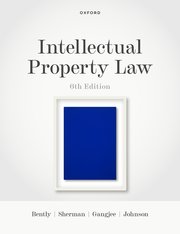| |
Pris: 743 SEK exkl. moms  |  Intellectual Property Law is the definitive textbook on the subject. The authors' all-embracing approach not only clearly sets out the law in relation to copyright, patents, trade marks, passing off, and confidentiality, but also takes account of a wide range of academic opinion enabling readers to explore and make informed judgements about key principles. The particularly clear and lively writing style ensures that even the most complex areas are lucid and comprehensible. Intellectual Property Law is the definitive textbook on the subject. The authors' all-embracing approach not only clearly sets out the law in relation to copyright, patents, trade marks, passing off, and confidentiality, but also takes account of a wide range of academic opinion enabling readers to explore and make informed judgements about key principles. The particularly clear and lively writing style ensures that even the most complex areas are lucid and comprehensible.
- Provides a detailed analysis of intellectual property law with reference to a wide range of academic opinion, giving readers a broad context in which to explore the key principles of the subject
- Writing style is particularly clear - the authors retain clarity whilst including an impressive amount of detail, and discussion of even the most complex areas is lucid and structured
- Anticipates new developments in the field in more depth than other textbooks, ensuring that readers are able to make informed judgements about forthcoming changes in the law, and understand the direction in which IP law is moving
New to this Edition:
- Coverage of the implications of Brexit for intellectual property law, including the key changes made to UK law and the relevance of post-Brexit EU decisions in the UK
- New UK case law on copyright subject matter, joint authorship, fair dealing for reporting current events, AI machines as inventors, the latest developments on misuse of private information including the protection of suspects (Bloomberg v ZXC and the Sir Cliff Richard case) and the right to defend oneself (Duchess of Sussex case), bad faith as a response to the problem of unused trade mark (Skykick), along with the Supreme Court decisions of Actavis, Regeneron, and Shanks
- Takes account of latest CJEU case law, in particular on subject matter (Levola Hengelo, Cofemel), communication to the public with respect to intermediaries, infringement, and defences (Huetter v Pelham, Spiegel Online, and Funke Medien)
- Takes account of latest cases at the EPO including Bentley Systems and the Pepper decisions
- Includes substantially revised chapters on geographical indications and misuse of private information
Table of Contents
1:Introduction
I. Copyright
2:Introduction to copyright
3:Subject matter
4:Criteria for protection
5:Authorship and first ownership
6:Nature of the rights
7:Duration of copyright
8:Infringement
9:Defences
10:Moral rights
11:Exploitation and use of copyright
12:Limits on exploitation
13:Rights associated with copyright
II. Patents
14:Introduction to patents
15:Nature of a patent
16:Procedure for grant of a patent
17:Patentable subject matter
18:Novelty
19:Inventive step
20:Internal requirements for patentability
21:Ownership
22:Infringement
23:Exploitation
24:Rights relating to patents
III. The Legal Regulation of Designs
25:How design protection arises in the United Kingdom
26:Subject matter: the requirement that there be a design
27:Grounds for invalidity: novelty, individual character, and relative grounds
28:Ownership, exploitation, and infringement: Registered designs and supplementary unregistered designs
29:Copyright protection for designs
30:Design right
IV. Trade Marks and Passing Off
31:Introduction to passing off and trade marks
32:Passing off
33:Misrepresentation
34:Damage
35:Trade mark registration
36:Subject matter
37:Absolute grounds for refusal
38:Relative grounds for refusal
39:Revocation
40:Infringement
41:Trade mark defences
42:Exploitation and use of trade marks
43:Geographical indications of origin
V. Confidential Information
44:Is the information capable of being protected?
45:Obligation of confidence
46:Breach and defences
47:Misuse of private information
VI. Litigation and Remedies
48:Litigation
49:Civil and criminal remedies | | |
|